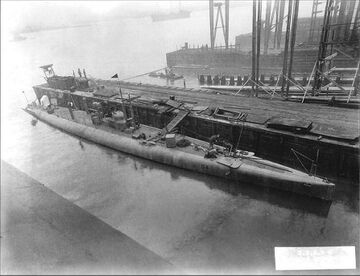G-4: Difference between revisions
From PigBoats.COM
Pbc captain (talk | contribs) No edit summary |
Pbc captain (talk | contribs) No edit summary |
||
| Line 17: | Line 17: | ||
File:G4-g4launch32-06.jpg|<big>Now the stern is lifting off the cradle and water pressure is rolling her more to her to port side. The shipyard workers on deck are diving and scrambling to avoid being tossed into the water as she begins to float free of the building cradle.</big> | File:G4-g4launch32-06.jpg|<big>Now the stern is lifting off the cradle and water pressure is rolling her more to her to port side. The shipyard workers on deck are diving and scrambling to avoid being tossed into the water as she begins to float free of the building cradle.</big> | ||
</gallery> | </gallery> | ||
---- | |||
Revision as of 21:41, 1 March 2023

The USS G-4, date circa 1912, at the Cramp yard during her 'fitting out' period. A good top view of some of her more unusual features. The bow planes lay flat on the fore deck. They fold out and down an lock on to an axle that then rotates the planes to dive and rise positions. Hard to see at the stern, the stern planes operate like the bow planes and are partly extended. The port plane can be seen as a square shape just forward of the 'doghouse' on the stern. The starboard plane is actually seen edge on but its reflection can be seen in the water and you can seen its square shape there. In the fully extended position the both sets of planes would be flat to the water. Cramp yard slipways can be seen in the background.



